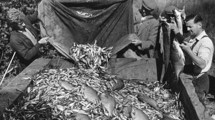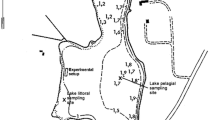Abstract
In order to evaluate short-term and long-term effects of fish manipulation in shallow, eutrophic lakes, empirical studies on relationships between lake water concentration of total phosphorus (P) and the occurrence of phytoplankton, submerged macrophytes and fish in Danish lakes are combined with results from three whole-lake fish manipulation experiments. After removal of less than 80 per cent of the planktivorous fish stock a short-term trophic cascade was obtained in the nutrient regimes, where large cyanobacteria were not strongly dominant and persistent. In shallow Danish lakes cyanobacteria were the most often dominating phytoplankton class in the P-range between 200 and 1 000µg P l−1. Long-term effects are suggested to be closely related to the ability of the lake to establish a permanent and wide distribution of submerged macrophytes and to create self-perpetuating increases in the ratio of piscivorous to planktivorous fish. The maximum depth at which submerged macrophytes occurred, decreased exponentially with increasing P concentration. Submerged macrophytes were absent in lakes>10 ha and with P levels above 250–300µg P l−1, but still abundant in some lakes<3 ha at 650µg P l−1. Lakes with high cover of submerged macrophytes showed higher transparencies than lakes with low cover aboveca. 50µg P l−1. These results support the alternative stable state hypothesis (clear or turbid water stages). Planktivorous fish>10 cm numerically contributed more than 80 per cent of the total planktivorous and piscivorous fish (>10 cm) in the pelagical of lakes with concentrations above 100µg P l−1. Below this threshold level the proportion of planktivores decreased markedly toca. 50 per cent at 22µg P l−1. The extent of the shift in depth colonization of submerged macrophytes and fish stock composition in the three whole-lake fish manipulations follows closely the predictions from the relationships derived from the empirical study. We conclude that a long-term effect of a reduction in the density of planktivorous fish can be expected only when the external phosphorus loading is reduced to below 0.5–2.0 g m−2 y−1. This loading is equivalent to an in-lake summer concentration below 80–150µg P l−1. Furthermore, fish manipulation as a restoration tool seems most efficient in shallow lakes.
Similar content being viewed by others
References
Andersson, G., S. Hamrin, O. Lessmark & L. Persson, 1985. Fish composition and fish manipulation in eutrophic lake ecosystems — final report. [Fisksamhällan och fiskemanipulering i eutrofa sjöekosystem — slutrapport]. Institute of Limnology, University of Lund, ISSN 0348-0798, 24 pp. (in Swedish).
Benndorf, J., 1987. Food web manipulation without nutrient control: a useful strategy in lake restoration? Schweiz. z. Hydrol. 49: 237–248.
Benndorf, J., H. Schulz, A. Benndorf, R. Unger, E. Penz, H. Kneschke, K. Kossatz, R. Dumke, U. Hornig, R. Kruspe & S. Reichel, 1988. Food-web manipulation by enhancement of piscivorous fish stocks: long-term effects in the hypertrophic Bautzen reservoir. Limnologica 19: 97–110.
Benndorf, J., 1990. Conditions for effective biomanipulation: conclusions derived from whole-lake experiments in Europe. Hydrobiologia 200/201: 187–203.
Berger, C., 1989. In situ primary production, biomass and light regime in the Wolderwijd, the most stable Oscillatoria agardhii lake in The Netherlands. Hydrobiologia 185: 233–244.
Carpenter, S. R., J. K. Kitchell & J. R. Hodgeson, 1985. Cascading trophic interactions and lake productivity. BioScience 35: 634–639.
Cryer, M., G. Peirson & C. R. Townsend, 1986. Reciprocal interactions between roach (Rutilus rutilus L.) and zooplankton in a small lake: prey dynamics and fish growth and recruitment. Limnol. Oceanogr. 31,5: 1022–1038.
Faafeng, B. A. & Å. Braband, in press. Biomanipulation of a small urban lake — removal of fish exclude bluegreen blooms. Verh. int. Ver. Limnol.
Grimm, M. P., 1989. Northern pike (Esox lucius) and aquatic vegetation, tools in the management of fisheries and water quality. Hydrobiol. Bull. 23: 59–65.
Hosper, S. H. & E. Jagtman, 1990. Biomanipulation additional to nutrient control for restoration of shallow lakes in the Netherlands. Hydrobiologia 200/201: 523–534.
Irvine, K., B. Moss & H. Balls, 1989. The loss of submerged plants with eutrophication. II. Relationships between fish and zooplankton in a set of experimental ponds, and conclusions. Freshwat. Biol. 22: 89–107.
Jensen, J. P., E. Jeppesen, P. Kristensen & S. N. Nielsen, 1990. Biologiske strukturmodeller for lavvandede søer. Status fase 1 og 2 [Modelling biological structure in shallow lakes. Status phase 1 and 2]. National Environmental Research Institute, Division of Freshwater Ecology, Silkeborg (in Danish).
Jeppesen, E., M. Søndergaard, E. Mortensen, P. Kristensen, B. Riemann, H. J. Jensen, J. P. Müller, O. Sortkjær, J. P. Jensen, K. Christoffersen, S. Bosselmann & E. Dall, 1990. Fish manipulation as a lake restoration tool in shallow, eutrophic, temperate lakes 1: cross-analysis of three Danish case-studies. Hydrobiologia 200/201: 205–218.
Koroleff, F., 1970. Determination of total phosphorus in natural water by means of the persulphate oxidation. An Interlab. report No. 3, Cons. Int. pour l'Explor de la Mer.
Kristensen, P., J. P. Jensen & E. Jeppesen, 1988. Reevaluation of simple lake models. NPO-project No. 4.5. Midterm status 1988 [Revurdering af simple sømodeller. NPO-projekt 4.5. Midtvejsrapport pr. 25 juli 1988]. Freshwater Laboratory, Silkeborg, Denmark: 15 pp. and 6 supplements (in Danish).
Lessmark, O., 1983. Influence of abiotic and biotic factors on the structure of perch and roach populations in thirteen Swedish lakes, with special reference to interspecific competition. Part of Ph.D. thesis, University of Lund, Sweden: 135–172.
Meijer, M.-L., M. W. de Haan, A. Breukelaar & H. Buiteveld, 1990. Is reduction of benthivorous fish an important cause of high transparency following biomanipulation in shallow lakes? Hydrobiologia 200/201: 303–315.
Mortensen, E., H. J. Jensen & J. P. Müller, in press. Guidelines for standardized testifishing in lakes and a description of fish gears and methods [Retningsliner for standardiseret forsøgsfiskeri i søer og en beskrivelse af fiskeredskader og-metoder]. National Environmental Research Institute (in Danish).
Moss, B., 1980. Ecology of fresh waters. Blackwell Scientific Publications London, 332 pp.
Murphy, J. & J. R. Riley, 1972. A modified single solution method for the determination of phosphate in natural waters. Analyt. chim. Acta 27: 21–26.
Olrik, M., 1978. Cyanophyceae and environmental factors in 15 Danish Lakes. Verh. int. Ver. Limnol. 20: 690–695.
Olrik, M., 1981. Succession of phytoplankton in response to environmental factors in Lake Arresø, North Zealand, Denmark. Schweiz. Z. Hydrol. 43,1: 6–19.
Persson, L., 1987. Effects of habitat and season on competitive interactions between roach (Rutilus rutilus) and perch (Percha fluviatilis). Oecologia 73: 170–177.
Persson, L., G. Andersson, S. F. Hamrin & L. Johansson, 1988. Predation regulation and primary production along the productivity gradient of temperate lake ecosystems. In S. R. Carpenter (ed.), Complex interactions in lake communities. Springer Verlag: 45–65.
Phillips, G. L., D. Eminson & B. Moss, 1978. A mechanism to account for macrophyte decline in progressively eutrophicated waters. Aquat. Bot. 4: 103–126.
Reinertsen, H., A. Jensen, J. I. Koksvik, A. Langeland & Y. Olsen, 1990. Effects of fish removal on the limnetic ecosystem of a eutrophic lake. Can J. Fish. aquat. Sci. 47: 166–173.
Reynolds, C. S., 1984. The ecology of freshwater phytoplankton. Cambridge University Press, 384 pp.
Riemann, B., K. Christoffersen, H. J. Jensen, J. P. Müller, C. L. Lindegaard & S. Bosselmann, 1990. Ecological consequences of a manual reduction of roach and bream in a eutrophic, temperate lake. Hydrobiologia 200/201: 241–250.
SAS Institute Inc., 1985. SAS user's guide: statistics. Version 5 edition. Cary, NC: SAS Institute Inc., 956 pp.
Sas H. (ed.), 1989. Lake restoration by reduction of nutrient loading. Expectation, experiences, extrapolation. Acad. Ver. Richarz GmbH, 497 pp.
Scheffer, M., 1989. Alternative stable states in eutrophic freshwater ecosystems. A minimal model. Hydrobiol. Bull. 23: 73–83.
Scheffer, M., 1990. Multiplicity of stable states in freshwater systems. Hydrobiologia 200/201: 475–486.
Shapiro, J., B. Forsberg, V. Lamarra, G. Lindemark, M. Lynch, E. Smeltzer & G. Zoto, 1982. Experiments and experiences in biomanipulation: studies of biological ways to reduce algal abundance and eliminate blue-greens. Environmental Protection Agency (EPA), 251 pp.
Søndergaard, M., E. Jeppesen, E. Mortensen, E. Dall, P. Kristensen & O. Sortkjær, 1990. Phytoplankton biomass reduction after planktivorous fish reduction in a shallow, eutrophic lake: a combined effect of reduced internal P-loading and increased zooplankton grazing. Hydrobiologia 200/201: 229–240.
Timms, R. M. & B. Moss, 1984. Prevention of growth of potentially dense phytoplankton populations by zooplankton grazing in the presence of zooplanktivorous fish in a shallow wetland ecosystem. Limnol. Oceanogr. 29: 472–486.
Author information
Authors and Affiliations
Rights and permissions
About this article
Cite this article
Jeppesen, E., Jensen, J.P., Kristensen, P. et al. Fish manipulation as a lake restoration tool in shallow, eutrophic, temperate lakes 2: threshold levels, long-term stability and conclusions. Hydrobiologia 200, 219–227 (1990). https://doi.org/10.1007/BF02530341
Issue Date:
DOI: https://doi.org/10.1007/BF02530341




